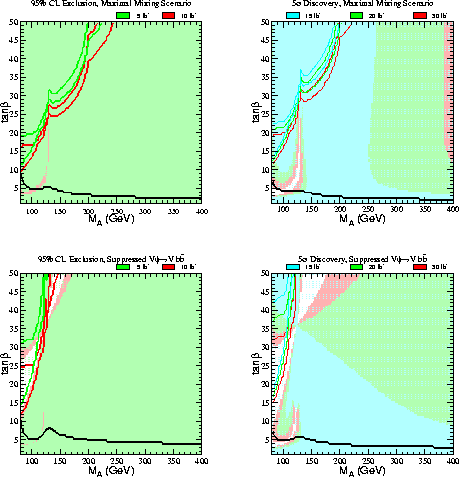
Workshop on the Future of Higgs Physics
May 3-5, 2001
Fermi National Accelerator Laboratory
Batavia, Illinois
 |
Workshop on the Future of Higgs PhysicsMay 3-5, 2001 |
The corresponding lower bound on the SM Higgs mass is mH > 113.3 GeV.
LEP results for the MSSM Higgs search can be found in the Note for ICHEP'2000 (Osaka, Japan, July 26 - Aug 2, 2000). See pages 15, 16 and 17 of the note for (preliminary) MSSM Higgs exclusion plots. A slightly more up to date plot for the Max-mh scenario is on slide 22 of Tom Junk's talk at LEP Fest Oct. 10, 2000 (ps, pdf). The mass limits for the light CP even and CP odd Higgs bosons are mh > 89.9 GeV and mA > 90.5 GeV, respectively. Values of tan beta are excluded from 0.52 to 2.25.


In each of the two scenarios, the 95% CL exclusion regions and the 5-sigma discovery regions are shown for two different search channels: (i) shaded regions correspond to V+Higgs (where V=W or Z and the associated Higgs boson is one of the two CP-even Higgs scalars of the MSSM---h or H), and (ii) regions in the upper left-hand corner of the graphs bounded by the solid lines correspond to b b-bar Higgs production (where the associated neutral Higgs boson is either h, H or A). Different integrated luminosities are explicitly shown by the color coding. Note that the same colors correspond to different integrated luminosities in the 95% CL and 5-sigma plots. For search channel (ii), the two sets of lines (for a given color) correspond to the CDF and D0 simulations, respectively. The region below the solid black line near the bottom of the plot is excluded by the absence of observed e+e- ---> Z + Higgs events at LEP2.
Further details and a literature survey can be found on the Higgs working group webpage. The final Higgs Working Group Report is available on the Los Alamos archives, hep-ph/0010338 (5.175 MB of gzipped postscript).
A study of p pbar -> t tbar H as a discovery mode for the Higgs boson at the Tevatron is in Phys. Rev. Lett. 86, 1694 (2001)
A Workshop on Monte Carlo generator physics for Run II at the Tevatron will be held at Fermilab from April 18-20, 2001, and will include Higgs physics at the Tevatron as one of the topics.
In the MSSM, one or more MSSM Higgs bosons can be discovered throughout
parameter space:
* ATLAS plots of MSSM Higgs discovery regions in the no mixing scenario with
30 fb-1 or
300 fb-1.
* ATLAS plot of MSSM Higgs discovery reach in the max-mh scenario with
300 fb-1.
(Note that the LEP exclusion contours shown in the ATLAS plots were
predictions; for the actual exclusion contours from LEP data
see the LEP section above.)
* CMS plot of MSSM Higgs discovery regions: see
page 14 of the
CMS TP Chapter 12 (1M ps.Z).
The ATLAS Detector and Physics Performance TDR is here. Higgs physics is discussed in Chapter 19 (1.4M) [Erratum].
The CMS Technical Proposal is here. Physics performance is in Chapter 12 (1M ps.Z).
- Measurements of ratios of Higgs partial widths can be extracted from combinations of cross sections times branching ratios. [link to come]
An ongoing study of Linear Collider physics has been in progress at Fermilab. A report is being prepared that summarizes the physics prospects of a 500-1000 GeV e+e- collider, with particular emphasis on Higgs physics.
In October 2000 the 5th International Linear Collider Workshop (LCWS 2000) was held at Fermilab, and included a parallel session on Higgs and SUSY Higgs. Slides are available on the web.
- Higgs mass determination [link to come]
- Higgs branching ratio and cross section measurements [link to come]
- Distinguishing models [link to come]
- 1 or 2 plots?
The Tesla TDR will contain information on the gamma-gamma option.
- H -> gamma gamma partial width measurement [link to come]
- Reach for heavy MSSM Higgs bosons [link to come]
- Higgs CP properties [link to come]